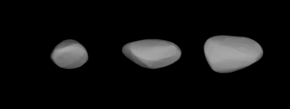787 Moskva is a minor planet orbiting the Sun. It is a dynamic member of the Maria asteroid family orbiting near the 3:1 Kirkwood gap.[4] This is an S-type (stony) asteroid spanning 27 km.[5] The surface mineralogy is consistent with mesosiderite silicates.[4]
 A three-dimensional model of 787 Moskva based on its light curve | |
| Discovery | |
|---|---|
| Discovered by | G. N. Neujmin |
| Discovery site | Simeis |
| Discovery date | 20 April 1914 |
| Designations | |
| (787) Moskva | |
| Pronunciation | /mɒskˈvɑː/ mosk-VAH[1] |
| 1914 UQ | |
| Orbital characteristics[2] | |
| Epoch 31 July 2016 (JD 2457600.5) | |
| Uncertainty parameter 0 | |
| Observation arc | 100.47 yr (36695 d) |
| Aphelion | 2.8690 AU (429.20 Gm) |
| Perihelion | 2.2090 AU (330.46 Gm) |
| 2.5390 AU (379.83 Gm) | |
| Eccentricity | 0.12996 |
| 4.05 yr (1477.7 d) | |
| 18.5642° | |
| 0° 14m 37.032s / day | |
| Inclination | 14.852° |
| 183.890° | |
| 126.135° | |
| Physical characteristics | |
| 13.755±1.4 km | |
| 6.056 h (0.2523 d)[3][2] | |
| 0.2559±0.062 | |
| 9.7 | |
Object 1914 UQ, discovered 20 April 1914 by Grigory Neujmin, was named 787 Moskva, after the capital of Russia, Moscow (and retains that name to this day). Object 1934 FD discovered on 19 March 1934 by C. Jackson was given the sequence number 1317. In 1938, G. N. Neujmin found that asteroid 1317 and 787 Moskva were, in fact, the same object. Sequence number 1317 was later reused for the object 1935 RC discovered on 1 September 1935 by Karl Reinmuth; that object is now known as 1317 Silvretta.
Photometric observations at the Palmer Divide Observatory in Colorado Springs, Colorado in 1999 were used to build a light curve for this object. The asteroid displayed a rotation period of 6.056 ± 0.001 hours and a brightness variation of 0.62 ± 0.01 in magnitude.[3]
References
edit- ^ Noah Webster (1884) A Practical Dictionary of the English Language
- ^ a b "787 Moskva (1914 UQ)". JPL Small-Body Database. NASA/Jet Propulsion Laboratory. Retrieved 5 May 2016.
- ^ a b Warner, Brian D. (January 2011), "Upon Further Review: IV. An Examination of Previous Lightcurve Analysis from the Palmer Divide Observatory", The Minor Planet Bulletin, vol. 38, no. 1, pp. 52–54, Bibcode:2011MPBu...38...52W.
- ^ a b Fieber-Beyer, S. K.; Gaffey, M. J.; Kelley, M. S.; Reddy, V.; Reynolds, C. M.; Hicks, T. (2011), "The Maria asteroid family: Genetic relationships and a plausible source of mesosiderites near the 3: 1 Kirkwood Gap", Icarus, 213 (2): 524–537, Bibcode:2011Icar..213..524F, doi:10.1016/j.icarus.2011.03.009.
- ^ Husárik, M., "CCD Photometry of Asteroids at the Skalnate Pleso Observatory and Shapes Modelling Methods." (PDF), In British/Czech and Slovak INYS workshop Many Faces of the Universe: From Solar System to Cosmology, pp. 30–1, retrieved 15 August 2021.
External links
edit- Lightcurve plot of 787 Moskva, Palmer Divide Observatory, B. D. Warner (1999)
- Asteroid Lightcurve Database (LCDB), query form (info Archived 16 December 2017 at the Wayback Machine)
- Dictionary of Minor Planet Names, Google books
- Asteroids and comets rotation curves, CdR – Observatoire de Genève, Raoul Behrend
- Discovery Circumstances: Numbered Minor Planets (1)-(5000) – Minor Planet Center
- 787 Moskva at AstDyS-2, Asteroids—Dynamic Site
- 787 Moskva at the JPL Small-Body Database